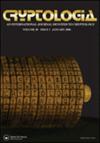解Olum 2密码:一种新的转置密码的密码分析方法
IF 0.4
4区 工程技术
Q4 COMPUTER SCIENCE, THEORY & METHODS
引用次数: 0
摘要
Olum 2是数学家Paul Olum在75年前为挑战他的曼哈顿计划同事、物理学家Richard Feynman而创造的两个密码之一。在这份手稿中,我描述了使用一种新的方法对置换密码进行密码分析的第一次成功解密Olum 2。为了解密Olum 2,我为所有可能的换位间隔生成了双字符和三字符。然后,我识别了在英语中经常出现的多个双字母和三字母的换位间隔。我计算了它们的英文频率与随机重新排列密文所产生的双字母和三字母的频率之比。这使我能够以最高的概率识别字母序列是真正的密码信息组件,而不是偶然发生的。在《奥鲁姆2》中,奥鲁姆教授将信息分成35个字母的部分,并使用旋转键来改变每个连续部分的换位顺序。他的策略不仅让费曼教授感到困惑,而且被证明无法破解目前使用的几种解密程序,这些程序假设整个密码都采用了统一的换位。本手稿中描述的解密方法可以协助采用各种换位方法的其他密码的解密。本文章由计算机程序翻译,如有差异,请以英文原文为准。
Solving the Olum 2 cipher: a new approach to cryptanalysis of transposition ciphers
Abstract Olum 2 is one of two ciphers created more than 75 years ago by mathematician Paul Olum to challenge his Manhattan Project officemate, physicist Richard Feynman. In this manuscript, I describe the first successful decryption of Olum 2 using a novel approach to cryptanalysis of transposition ciphers. To decrypt Olum 2, I generated the bigrams and trigrams for all possible transposition intervals. I then identified transposition intervals with multiple bigrams and trigrams that occur frequently in English. I calculated the ratios of their English frequencies to the frequencies of bigrams and trigrams generated by a random reordering of the ciphertext. This enabled me to identify letter sequences with the highest probability of being true cipher message components rather than occurring by chance. In Olum 2, Professor Olum divided the message into sections of thirty-five letters and applied a rotating key to change the order of transposition for each successive section. His strategy not only confounded Professor Feynman but also proved impervious to several decryption programs in use today that assume a uniform transposition has been applied throughout the cipher. The decryption methods described in this manuscript can assist in the decryption of other ciphers employing a variety of transposition methods.
求助全文
通过发布文献求助,成功后即可免费获取论文全文。
去求助
来源期刊

Cryptologia
工程技术-计算机:理论方法
自引率
33.30%
发文量
31
审稿时长
24 months
期刊介绍:
Cryptologia is the only scholarly journal in the world dealing with the history, the technology, and the effect of the most important form of intelligence in the world today - communications intelligence. It fosters the study of all aspects of cryptology -- technical as well as historical and cultural. The journal"s articles have broken many new paths in intelligence history. They have told for the first time how a special agency prepared information from codebreaking for President Roosevelt, have described the ciphers of Lewis Carroll, revealed details of Hermann Goering"s wiretapping agency, published memoirs - written for it -- of some World War II American codebreakers, disclosed how American codebreaking affected the structure of the United Nations.
 求助内容:
求助内容: 应助结果提醒方式:
应助结果提醒方式:


